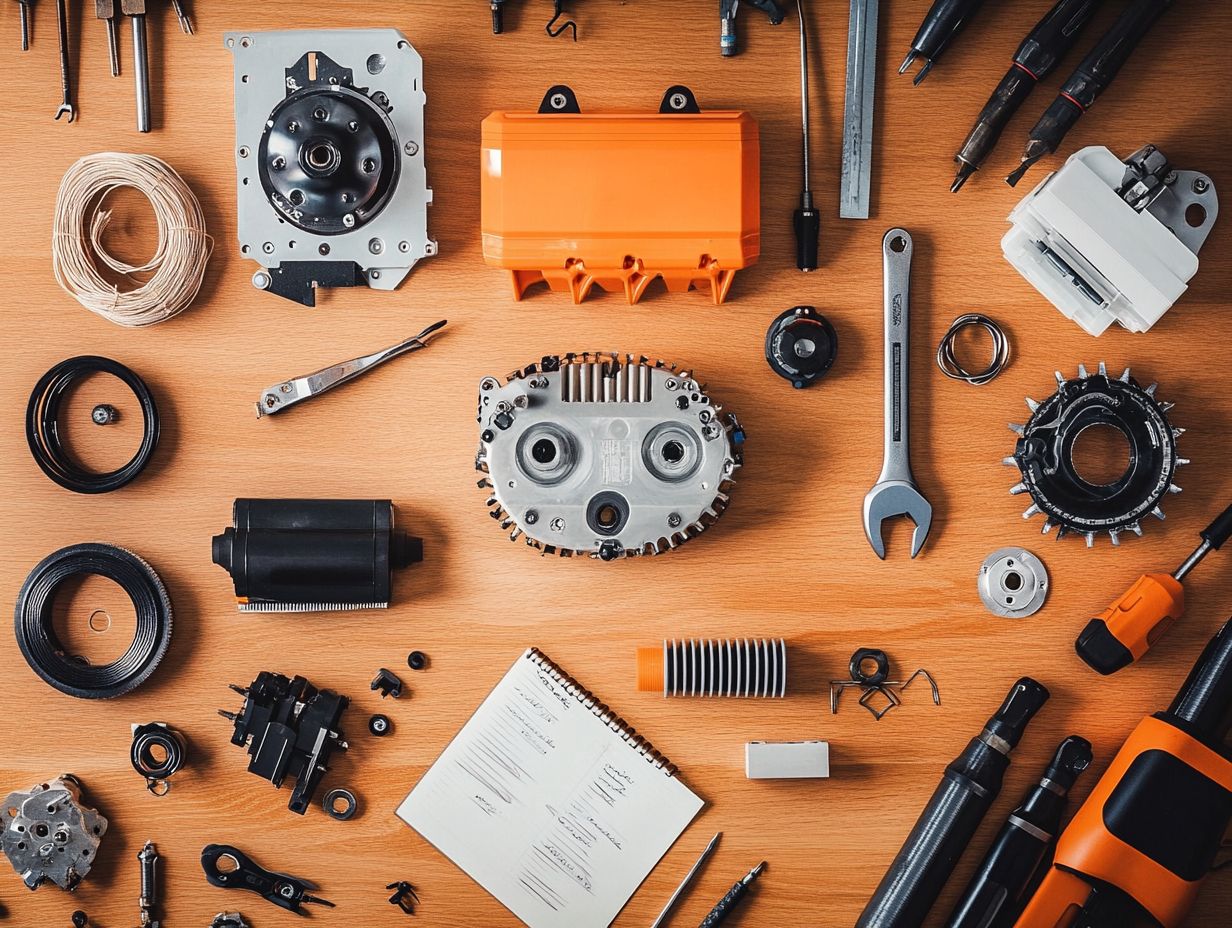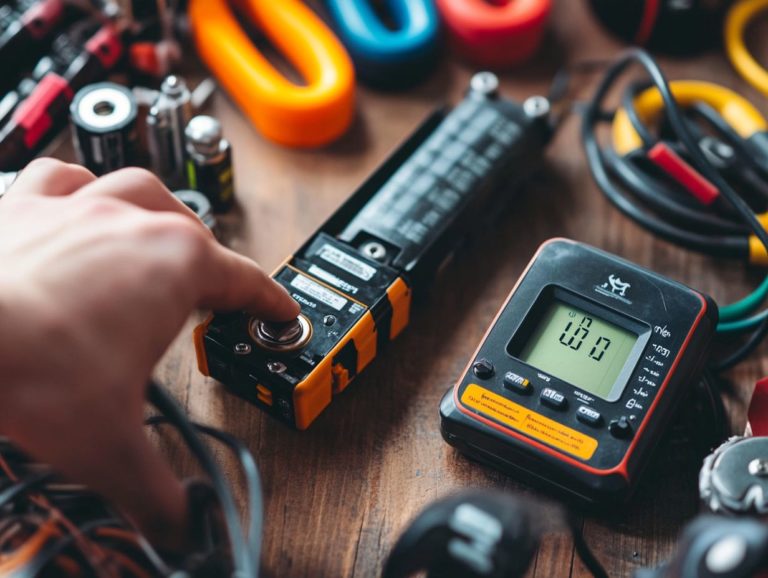Choosing the Right Motor for Your E-Bike
Choosing the right motor for your e-bike can greatly improve your riding experience. However, with so many options available, it may seem overwhelming.
This guide also highlights popular e-bike motor brands and provides important tips for installation and maintenance, ensuring that your ride is smooth and efficient.
Get ready to power up your adventures!
Contents
- Key Takeaways:
- Types of Motors and Their Differences
- Factors to Consider When Choosing a Motor
- Popular E-Bike Motor Brands
- Installation and Maintenance Tips
- Frequently Asked Questions
- What factors should I consider when choosing the right motor for my e-bike?
- What is the difference between a hub motor and a mid-drive motor?
- What is the power rating of a motor and how does it affect my e-bike?
- Can I upgrade the motor on my e-bike if I am not satisfied with its performance?
- What is the maintenance required for e-bike motors?
- Are there any regulations or laws I should be aware of when choosing a motor for my e-bike?
Key Takeaways:

- Consider your budget and performance needs when choosing an e-bike motor.
- Check for battery compatibility when selecting an e-bike motor.
- Ensure proper installation and maintenance to keep your e-bike motor performing at its best.
Types of Motors and Their Differences
Electric bikes, or e-bikes, have surged in popularity due to their sustainability and efficiency, making them an attractive alternative to traditional bicycles.
At the heart of an e-bike’s performance lies its motor a crucial element that shapes its capabilities. There are two primary types: hub motors and mid-drive motors. Hub motors, located in the wheel, provide smooth, direct power. Mid-drive motors, situated near the pedals, offer better handling on hills. When considering your options, it’s important to explore choosing between different electric bicycle types to find the best fit for your needs.
Hub motors can be split into front and rear varieties, while mid-drive motors stand out with their unique advantages in handling and power output.
Factors to Consider When Choosing a Motor
When choosing an electric bike motor, consider your performance needs, budget limitations, and the terrain you intend to conquer.
Your preferred riding style significantly impacts your motor choice, as different motors deliver distinct power outputs and handling characteristics.
It’s also essential to ensure that your selected motor is compatible with your rechargeable battery. This compatibility is key to maximizing your e-bike experience and affects factors like weight distribution and overall motor performance.
Budget and Performance Needs
When selecting the perfect electric bike motor, budget considerations take center stage. Prices can vary significantly based on performance capabilities, particularly with motors like 350W, 500W, and 750W.
If you’re a casual rider, a 350W motor might be just the ticket for your short, flat commutes or leisurely weekend rides. In contrast, if you crave performance perhaps for tackling hilly terrains or off-road adventures, you may want to explore how to choose an electric bicycle type for you; a 750W motor could provide the power and speed that elevate your riding experience.
Remember that while higher wattage motors can enhance performance, they may also incur increased long-term maintenance costs, such as battery replacements and worn components. To make an informed decision, consider exploring electric bicycle types that suit your riding style and potential usage patterns. This way, you can choose a motor that fits your immediate budget and supports longevity while minimizing future expenses.
Terrain and Riding Style

The terrain you frequently ride on significantly influences your choice of e-bike motor. This choice impacts both performance and handling characteristics.
If you often tackle steep hills, you might favor mid-drive motors for their impressive torque, which helps you pedal better on hills. On the other hand, if you glide over flat surfaces, hub motors could be your go-to for a smooth and effortless ride. To learn more about selecting the best option for your preferences, check out this guide to choosing the right electric bicycle for your needs.
In hilly areas, mid-drive motors shine, offering efficient power distribution. This enhances your pedaling efficiency when navigating inclines. Conversely, on flat roads, hub motors make for a relaxed journey, ideal for your daily commute. If you’re considering an electric bicycle, check out our guide on how to choose the right electric bicycle brand.
When venturing onto off-road trails, mid-drive systems maintain traction and control over rough terrain. As a recreational rider, your needs may vary with different paths, underscoring the importance of selecting a motor that matches your riding style and the challenges of the terrain you encounter. To make an informed decision, consider learning how to navigate electric bicycle brand choices.
Battery Compatibility
Ensuring battery compatibility is crucial when selecting an electric bike motor. Each e-bike motor demands specific types of rechargeable batteries to perform at their best. Mismatching components can lead to reduced motor performance and an increasing list of maintenance tasks.
Picking the right battery can transform your ride and boost your e-bike’s performance! The battery s capacity is a game changer, directly influencing both range and power delivery. A battery with insufficient capacity can lead to shorter rides and inconsistent performance, making it tougher to conquer inclines or tackle longer distances.
On the flip side, opting for a higher-capacity battery could enhance performance, but it might also come with added weight or cost that you didn’t bargain for. Ultimately, picking the wrong battery type can detract from how well it works, leading to frustration and overshadowing the pure joy of e-biking.
Popular E-Bike Motor Brands
Several brands are leading the charge in the electric bike motor landscape, including industry heavyweights like Bosch, Brose, Shimano Steps, and Yamaha. These brands provide an impressive array of innovative solutions tailored to suit various riding preferences and performance needs.
Each brand brings its own unique advantages, whether it’s superior motor efficiency or exceptional support for different riding styles. To make the best choice, consider choosing the right electric bicycle type for you. These aspects significantly enhance your overall e-bike experience.
Features and Benefits of Each Brand
Each electric bike motor brand presents unique features and benefits designed to meet your specific needs. For instance, the Bafang Ultra stands out with its high power output. Meanwhile, the Bakcou Mule is your go-to for conquering rugged terrain and off-road adventures.
You might even consider alternative technologies like Duyunov’s motor wheel, which has been gaining attention for its innovative take on electric bike propulsion. Additionally, knowing how to select the best electric bike for your needs can further enhance your riding experience and enable you to choose motors that perfectly fit your cycling preferences.
Brands equipped with advanced torque sensors offer seamless pedal assist that adjusts in real time, providing you with intuitive control and a more natural ride. For additional insights, check out this guide on how to choose the right accessories for E-bikes. Motors with cadence sensors are ideal for commuters who value a smoother, more efficient pedal stroke.
This level of tailored functionality ensures that whether you re navigating bustling city streets or tackling thrilling trails, your e-bike’s performance will align with your individual riding style, leading to greater enjoyment and satisfaction overall.
Installation and Maintenance Tips

Proper installation and maintenance are crucial for achieving optimal motor performance in your electric bike. Neglecting these key aspects can lead to costly repairs and a diminished riding experience.
By adhering to a few essential installation tips, you can ensure a seamless setup. Regular maintenance keeps your motor in excellent condition, allowing you to enjoy every ride to the fullest.
Proper Installation Process
The proper installation process of e-bike motors is crucial for optimal performance and ensuring your safety. Familiarize yourself with the specific requirements of your chosen motor type, whether it’s a hub motor or mid-drive motor, and meticulously follow the manufacturer’s guidelines.
Having the right tools and equipment on hand can greatly enhance your installation experience. For hub motors, begin by removing the wheel from the bike frame. Then, carefully detach the existing hub to make space for the new motor. Additionally, consider 5 tips for selecting the right electric bike type to ensure you make the best choice for your needs.
When working with mid-drive systems, it’s essential to check the frame’s compatibility. Consider any necessary adjustments to the drivetrain, which is the system that transfers power from the motor to the wheels. Accurate alignment of components is key to ensuring a smooth ride.
Once the installation is complete, if you experience issues like erratic performance or strange noises, revisit the instructions. Confirm that all parts are properly secured and compatible with the battery and other components. Often, checking connections and adjusting settings can resolve these common problems.
Best Practices for Maintaining Your Motor
Keeping your electric bike motor in top shape is essential! Regular maintenance helps extend its lifespan. Embrace best practices like periodic inspections and thorough cleaning. Pay attention to the motor’s specific maintenance requirements based on its type and usage conditions.
For example, routinely checking the connections is essential. This helps you avoid loose wires or corrosion, both of which can hamper performance. Lubricating moving parts such as gears, bearings, and chains reduces friction and enhances overall functionality.
Monitoring battery health is crucial. A tired battery significantly impacts power output and efficiency. By addressing these maintenance tasks promptly, you can prevent performance degradation and enjoy a smoother, more reliable ride.
Neglecting these practices could lead to costly repairs and a diminished lifespan for your motor. Don t wait! Regular checks can save you from costly repairs!
Frequently Asked Questions
What factors should I consider when choosing the right motor for my e-bike?

Consider the terrain, your speed and range needs, and the motor s weight. Also, take into account your budget and the overall weight of the bike.
What is the difference between a hub motor and a mid-drive motor?
A hub motor is located in the wheel hub, while a mid-drive motor is located near the pedals. Hub motors are typically easier to install but can affect the bike’s balance, while mid-drive motors provide better torque and a more natural riding experience.
What is the power rating of a motor and how does it affect my e-bike?
The power rating of a motor is measured in watts and determines how much energy the motor can output. Higher power ratings can provide faster speeds and better acceleration but also drain the battery faster.
Consider your riding needs and preferences when choosing the power rating for your motor.
Can I upgrade the motor on my e-bike if I am not satisfied with its performance?
Yes, upgrading the motor on your e-bike is possible. However, this may require modifications to the bike and can be expensive. It is important to research and consult with a professional before making any upgrades.
What is the maintenance required for e-bike motors?
E-bike motors require minimal maintenance. Regularly clean and lubricate the chains and gears. It is also recommended to have the motor checked by a professional every 6-12 months for any necessary adjustments or repairs.
Are there any regulations or laws I should be aware of when choosing a motor for my e-bike?
Yes, regulations and laws regarding e-bike motors vary by country and region. Research and adhere to any guidelines for motor power and speed limits in your area. Failure to comply with these regulations may result in fines or legal consequences.






